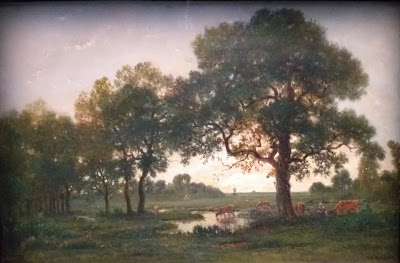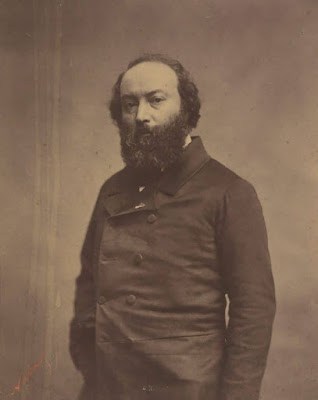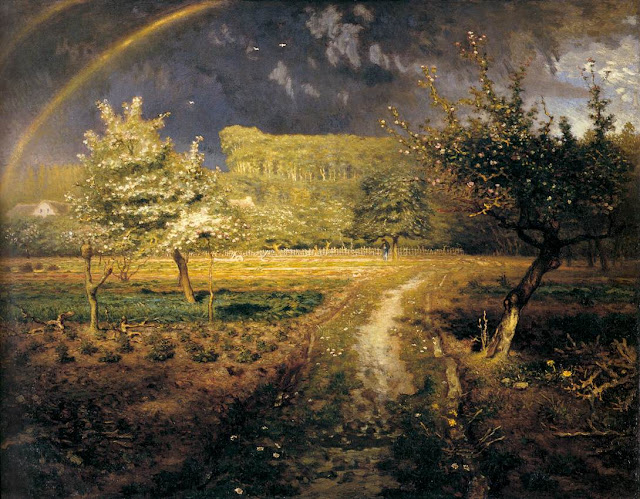 |
Arbre dans la forêt de Fontainebleau (Tree in the forest of Fontainebleau) 1840/1849
London Victoria and Albert Museum |
How such an exquisite painting of a tree could be seen as revolutionary is difficult to comprehend nowadays. Théodore Rousseau was one of the "Barbizon" painters who preferred natural scenes to the idealised landscapes and history paintings of the Academy. Rather than making the grand tour of Italy, he travelled round different regions of France, finally settling in the village of Barbizon two minutes' walk from the forest of Fontainebleau.
 |
| La Mare au Chêne (The Oak Pond) 1860-65 Cherbourg, Thomas-Henry Museum, on loan to Musée d'Orsay |
Rousseau was inspired by John Constable's works, exhibited in 1824 in Paris. Rousseau's colours are similar to the English artist's in this bucolic scene:
 |
| L'Abreuvoir (The drinking fountain) 1850-60 Oil on wood. Reims, Musée des Beaux Arts |
During his personal 'grand tour', Rousseau portrayed the countryside familiar to George Sand in the Berry region:
 |
| La Mare près de la Route, ferme dans le Berry (The Pond near the road, Farm in the Berry) 1845-48 oil on wood Musée d'Orsay |
On loan from a private collection, there is a magnificent sky and lake study done in the Jura region:
 |
| Le lac de Malbuisson (Malbuisson lake) ca 1831 oil on paper Private Collection |
The 19th century photographer Nadar has left us an image of Théodore Rousseau, in his mid forties.
 |
Nadar: photo of Théodore Rousseau, ca 1857 |
Rousseau (1812-1867) was the son of a Parisian tailor. He had a gift for drawing and although his father wanted him to become an engineer, he joined the arts school, studying under Jean-Charles-Joseph Rémond. However he found himself at odds with his teacher and refused to go in for the Rome prize which would have been a consecration of his career. Although his work was accepted at the Salons of 1831, 1833 and 1836, Rousseau soon gained the reputation of a rebel and spent 13 years out in the cold. His nickname was 'le grand refusé' (the great refused one'). 'Not properly finished' was often the criticism of the Salon jury. He produced the following large work while in the Vendée region. It gives us a grandiose view of nature. It was rejected from the 1841 Salon:
.jpg) |
| L'Allée des Châtaigniers (Avenue of Chestnut trees) 1837-41 Louvre |
 |
Une avenue, forêt de l'Isle-Adam (An Avenue, Isle-Adam Forest) 1849, Musée d'Orsay
|
When the "Republican"Salon of 1848 was held, Rousseau was one of the participants- not a problem for him, as there was exceptionally no jury in that year of revolution. His group of oak trees, which had already been purchased by the Duc de Morny, half-brother of the Emperor, was exhibited at the Paris World Fair of 1855:
 |
Groupe de chênes, Apremont (group of oaks, Apremont) 1850-52
|
It was seen against a background of galloping industrialisation and a certain nostalgia for what was being destroyed (Quick growing pine plantations were replacing centenary oaks).
A rare and interesting example of an early daguerreotype photo is included in the exhibition, portraying the trees in a manner similar to Rousseau's:
.jpg) |
Grands chênes (Tall Oaks) Fontainebleau forest? ca 1845 anonymous Musée d'Orsay
|
The Barbizon school preferred to paint nature on the spot, in the open air. The artists often stayed at the local inn- l'auberge Ganne.
It was easy for painters to set off in the early morning from the inn- to catch a sunrise perhaps- taking with them some provisions for the day.
One of the group who loved to paint dramatic light effects was Narcisse Diaz de la Peña:
 |
| Narcisse Diaz de la Peña: Lisière de forêt (Edge of the forest) 1871, Musée d'Orsay |
Many artists portrayed animals- as in Constant Troyon's tranquil scene of cows drinking in a pond:
 |
| Constant Troyon: Vâches buvant à une mare (Cows drinking at a pond) |
1853 Musée d'Orsay
In 1848 Rousseau took up permanent residence in Barbizon. He was joined by Jean-François Millet and Charles Jacque and their families, fleeing the cholera epidemic in Paris. Jacque specialised in chickens and sheep:
 n n |
| Charles Jacque: Moutons au pâturage (Grazing sheep) 1871, Musée d'Orsay |
Reputedly Jacque had some pet sheep who followed him around and were his models! Jacque eventually had a few differences with his companion painters when he went into large-scale chicken production. Rousseau, on the other hand, is described by the curators of this present exhibition as an early ecologist. He was certainly concerned about the destruction of the forest and, with the help of writer George Sand, persuaded the Emperor to declare a large area of the forest as a natural reserve for artists.
.jpg) |
| Le Chêne de roche (The rock oak) 1860 Copenhagen, Ny Carlsberg Glyptotek |
Rousseau shows us in this work an untamed view of an intimate corner of Fontainebleau forest, with no people. According to his first biographer and friend, Alfred Sensier, Rousseau 'heard the voices of the trees' and wanted to capture nature's grandeur. He renders the cragginess of the rock and the texture of the bark, as a detail may help to show:
 |
| Le chêne de roche (The rock oak) detail |
The oilpaint sketch on cardboard below might have been described as an act of delirium by his old teacher Rémond! The effect is dramatic. A stormy sky, conveyed by furious brushstrokes, is reflected in the pool in the foreground:
 |
Paysage avec ciel orageux (Landscape with stormy sky) ca 1842
London Victoria and Albert Museum |
By contrast, Rousseau's study of a branch and leaves below is a finely defined piece:
 |
Etude de branche d'arbre avec une feuille (Study of a tree branch and leaf) oil on wood ca 1829 Rotterdam, Museum Boijmans Van Beuningen
|
A striking work by Jean-François Millet has been loaned by the Musée d'Orsay. A lyrical representation of nature in springtime, with its dramatic lighting and rainbow, it was the first of a series that Millet never completed:
_-_Spring_-_WGA15693.jpg) |
| Jean-François Millet: Le Printemps (Spring) 1868-73 Musée d'Orsay |
It was thought to be a tribute to his dear friend Rousseau who had died a few months earlier.
Each artist had their distinct characteristics- Millet liked to paint peasants at work, and he did it with great reverence. His "Angélus" is one of the jewels of the Musée d'Orsay (not in this exhibition). The two painters were firm friends. Rousseau helped Millet and his large family financially, even to the point of pretending a rich American buyer had purchased one of Millet's paintings, so as not to embarrass his friend. Millet gave Rousseau moral support when Rousseau's wife was suffering from mental issues. A bronze plaque of the two artists and friends was made by sculptor Henri Chapu. The exhibition contains the original plaster mould:
 |
| Henri Chapu: Millet and Rousseau 1884 plaster, Musée Henri Chapu, Le-Mée-sur-Seine |
Paid for by public subscription, the bronze double portrait was inaugurated in April 1884 and is still there to be seen, cemented to a rock, at the edge of the forest.
The scenography of the exhibition is beautifully done, with large reproductions of sections of Rousseau's works on the dark green walls, while at the entrance there is a special lighting effect giving the impression of sunlight filtering through leaves onto the ground.
The Petit Palais, constructed for the world fair of 1900, is a fine building with a small interior garden. It houses the present Rousseau exhibition; the rest of its eclectic collection is always free of charge.
Elsewhere in the vast building, among its treasures, there are several works on permanent display by 17th century Dutch artists who were an inspiration to Théodore Rousseau and his colleagues:
 |
| Meindert Hobbema (1638-1709): Le Chemin dans la forêt (The forest path) |
The Barbizon painters were able to use the latest technological inventions, such as flexible metal tubes of paint and folding easels. The Petit Palais has set up the kind of equipment they would have used:
Paintings by the young artists who followed in the footsteps of the Barbizon school are also to be found among the Petit Palais' treasures:
 |
| Alfred Sisley: Lisière de la forêt de Fontainebleau (Edge of the forest of Fontainebleau) 1865 |
The new generation introduced the brighter-coloured skies of Impressionism.
Théodore Rousseau- La Voix de la forêt (the voice of the forest) Exhibition from 5th March to the 7th July, 2024 at the Petit Palais, Avenue Winston Churchill, 75008 Paris
Open Tuesday to Sunday from10am to 6pm and until 8pm on Friday and Saturday.
Closed Mondays.
Metro: Champs-Elysées/ Clemenceau
*****************






.jpg)

.jpg)

 n
n.jpg)



_-_Spring_-_WGA15693.jpg)





.jpg)

Comments
Post a Comment